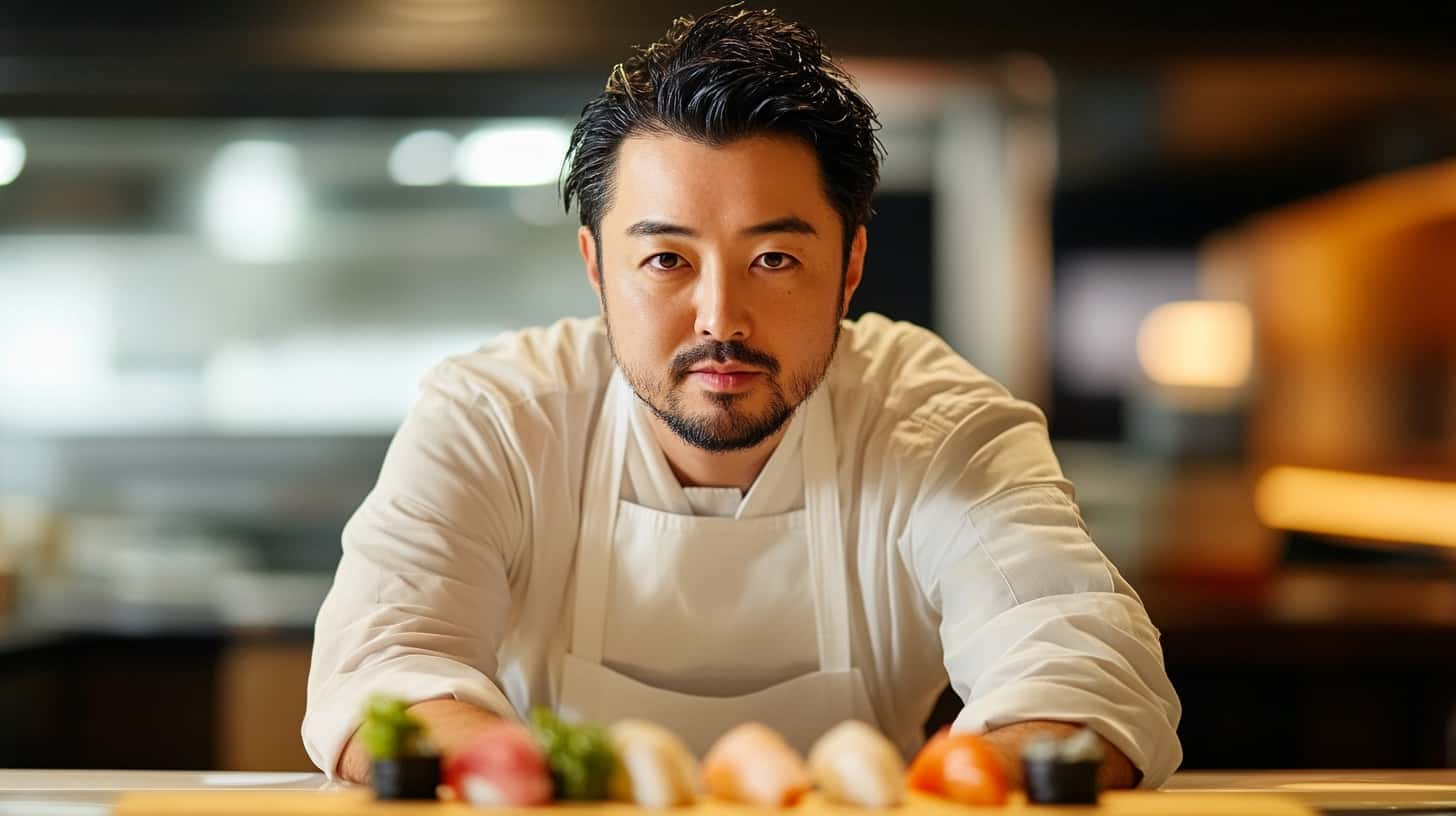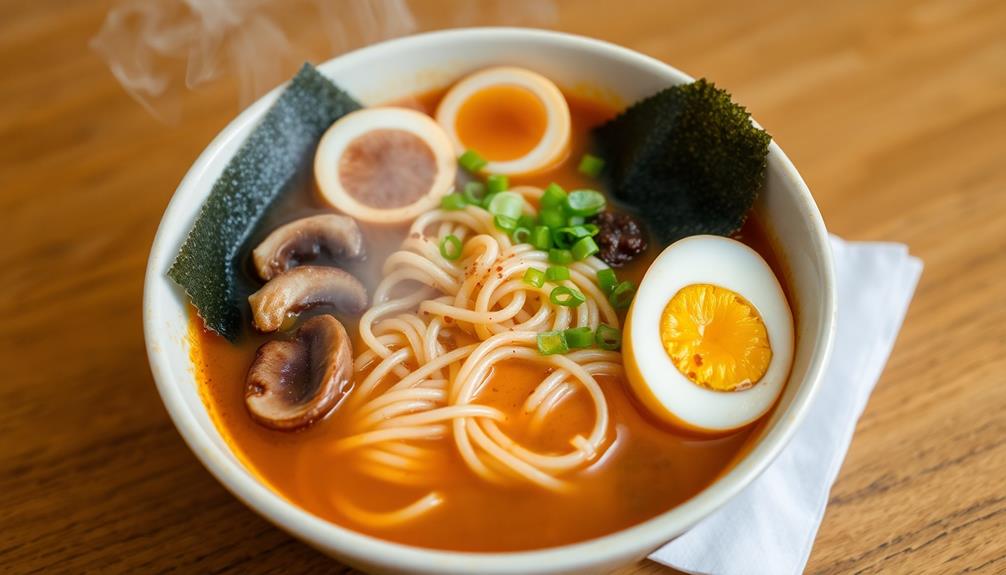Takoyaki are the mouthwatering Japanese octopus ball snacks you've got to try! These crispy, golden-brown bites originated in 1930s Osaka, where a street vendor named Tomekichi Endo first experimented with tasty fillings. Today, takoyaki are a beloved part of Japanese culture, featuring a fluffy wheat flour batter, tender octopus pieces, and mouthwatering toppings like savory sauce, creamy mayo, and crunchy bonito flakes. Making takoyaki is an interactive, social experience, and you can find these delightful snacks at bustling festivals, cozy restaurants, and casual street stalls across Japan. Ready to explore the irresistible world of takoyaki? Let's dive in!
Key Takeaways
- Takoyaki is a popular Japanese street food made of bite-sized fried balls filled with octopus, tempura scraps, green onions, and other savory ingredients.
- Takoyaki originated in Osaka, Japan during the 1930s and has since become a staple snack enjoyed nationwide, often served at festivals and casual dining spots.
- The key ingredients in takoyaki include a wheat flour-based batter, diced octopus, and toppings such as takoyaki sauce, Japanese mayonnaise, bonito flakes, and aonori (seaweed).
- Preparing takoyaki involves carefully pouring the batter into a specialized pan, adding the fillings, and continuously rotating the balls to achieve a crispy exterior and soft, gooey interior.
- Takoyaki is known for its unique sensory experience and is considered a symbolic dish that represents the fusion of traditional and modern Japanese cuisine.
History
Where did the takoyaki snack originate from? You'll be delighted to know that this tasty treat has its roots in the vibrant city of Osaka, Japan!
Back in the 1930s, a savvy street vendor named Tomekichi Endo started experimenting with different fillings, eventually landing on the perfect combination – juicy octopus pieces nestled in a fluffy, golden-brown batter.
The name "takoyaki" comes from the Japanese words for "octopus" (tako) and "fried" (yaki), perfectly describing this beloved snack.
As word of Endo's creation spread, takoyaki shops began popping up all over Osaka, each with its own unique spin on the classic recipe.
Today, you can find these delightful octopus balls in every corner of Japan, enjoyed by people of all ages.
Whether you're strolling through a bustling festival or relaxing at a cozy izakaya, the aroma of sizzling takoyaki is sure to make your mouth water!
Recipe
Takoyaki, a beloved Japanese street food, is a delightful bite-sized treat that combines the savory flavors of octopus, dashi broth, and a variety of seasonings. These spherical snacks are a must-try for anyone looking to explore the rich culinary traditions of Japan.
At the heart of takoyaki lies a batter made from wheat flour, dashi stock, and eggs, which creates a light and fluffy interior. The real magic, however, lies in the fillings – tender pieces of octopus, aonori (dried green seaweed), pickled ginger, and crispy tempura scraps that add a delightful crunch.
- Batter: 1 cup all-purpose flour, 1 cup dashi stock, 2 eggs, 1 tablespoon soy sauce, 1 teaspoon sugar
- Fillings: 1 cup chopped cooked octopus, 2 tablespoons aonori (dried green seaweed), 2 tablespoons pickled ginger, 2 tablespoons tempura scraps
- Toppings: Takoyaki sauce, Japanese mayonnaise, bonito flakes, chopped green onions
To prepare the takoyaki, heat a specialized takoyaki pan or a regular non-stick pan with round indentations. Ladle the batter into the hot pan, filling each well about three-quarters full.
Quickly add a piece of octopus, a sprinkle of aonori, pickled ginger, and tempura scraps to the center of each ball. Cook, turning the balls frequently with chopsticks or a skewer, until golden brown and cooked through, approximately 8-10 minutes.
Remember to have all your ingredients prepped and ready to go, as the cooking process moves quickly. Serve the takoyaki hot, drizzled with takoyaki sauce, Japanese mayonnaise, bonito flakes, and chopped green onions.
Enjoy the delightful burst of flavor in every bite!
Cooking Steps
Let's get cooking!
First, you'll whip up a tasty takoyaki batter mixture.
Next, pour that batter into the special takoyaki pan, add your octopus pieces, and cook until everything's nice and browned.
Step 1. Make Takoyaki Batter Mixture

To make the takoyaki batter mixture, you'll need to whisk together the flour, egg, and dashi stock in a large bowl until the batter is smooth and free of lumps. The flour creates the perfect fluffy texture, while the egg adds richness and the dashi stock provides savory umami flavor.
Once the batter is ready, you can start preparing the other ingredients. Chop the green onions, pickled ginger, and octopus into small, bite-sized pieces. These colorful toppings will add wonderful pops of flavor and texture to your takoyaki.
Next, heat up your takoyaki pan and grease the wells. Using a small ladle or pitcher, carefully pour the batter into each well, filling them about three-quarters full.
Top each one with a few pieces of the octopus, green onions, and ginger. As the takoyaki cook, use your skewers to gently turn them, creating their signature round shape.
In no time, you'll have a delightful batch of piping hot, golden-brown takoyaki ready to enjoy!
Step 2. Pour Batter Into Takoyaki Pan

With your batter ready, it's time to start cooking! Grab your trusty takoyaki pan and get ready for some delicious octopus ball action. Carefully pour a small amount of batter into each of the round wells, filling them about three-quarters full.
Be sure to work quickly, as the batter will start to set right away.
Now, it's time to add your fillings! Drop a small cube of octopus into the center of each ball, followed by a sprinkle of green onions and pickled ginger.
Don't be afraid to get creative – you can also try adding cheese, shrimp, or even bacon bits!
As the takoyaki cook, use your special takoyaki tools to turn and rotate the balls, ensuring they cook evenly on all sides.
Listen for that satisfying sizzle and keep an eye on them, adjusting the heat as needed.
Once they're golden brown and fluffy, it's time to transfer them to a plate and get ready to enjoy your homemade Japanese treat!
Step 3. Add Octopus Pieces

Once the batter is poured, it's time to add the star of the show – the octopus pieces.
You'll want to get your hands on some fresh, tender octopus, cut into bite-sized chunks. Carefully drop a few pieces into each well of the hot takoyaki pan. The octopus will start to sizzle and curl up as it cooks, filling the air with a delightful savory aroma.
Be sure to distribute the octopus evenly, so each takoyaki ball gets a tasty morsel. As the batter cooks around the octopus, you'll see the edges start to turn golden brown.
Use your takoyaki turner to gently rotate the balls, ensuring they cook evenly on all sides. The octopus should become tender and infuse the batter with its incredible flavor.
Get ready for an explosion of umami goodness in every bite!
Step 4. Cook Until Browned

As the takoyaki batter sizzles around the octopus morsels, it's time to start rotating and browning the balls. Using your trusty takoyaki pan, gently turn each ball a quarter turn every 30 seconds or so. This ensures even cooking and that lovely golden-brown crust forms all around.
You'll know they're ready when the outsides are nicely browned and the insides are cooked through.
Don't be afraid to get in there with your pick or skewer, carefully rotating each ball as it cooks. The key is to keep them moving, so the batter cooks up crisp and the octopus pieces warm up perfectly.
Listen for that satisfying sizzle as you turn them, and catch a whiff of the savory aroma filling the air. Before you know it, you'll have a pan full of piping hot, beautifully browned takoyaki, ready to enjoy.
Step 5. Flip and Cook Until Crispy

Carefully flipping the takoyaki, you'll want to cook them until they develop a delightfully crisp exterior. Use a pair of chopsticks or a small spatula to gently turn each ball, making sure to get an even golden-brown color all around.
As the takoyaki sizzle and dance in the pan, you'll start to smell the savory aroma of the cooked batter and fillings.
Keep a close eye on them, flipping and rotating the balls as needed to ensure they cook evenly. You'll know they're ready when the outside is crispy and the inside is hot and fluffy.
Don't be afraid to let them get a little charred in spots – that's where all the delicious, caramelized flavor comes from!
Once they're perfectly crispy, carefully transfer the takoyaki to a serving plate. Get ready to enjoy these warm, bite-sized morsels of Japanese street food perfection!
Final Thoughts
Enjoying the delightful takoyaki snacks is a delightful way to indulge in Japanese cuisine. These little octopus-filled balls are a true delight for the senses, with their crispy exteriors and savory, chewy interiors.
The combination of flavors, from the tender octopus to the tangy sauces, creates a truly unique and satisfying experience. Whether you're exploring the vibrant street food scene in Japan or recreating the experience at home, takoyaki are sure to leave a lasting impression.
The joy of watching the takoyaki sizzle and flip as they cook, followed by the first satisfying bite, is an experience that can be shared and enjoyed by people of all ages.
Frequently Asked Questions
What Is the Origin of the Name "Takoyaki"?
The name "takoyaki" comes from the Japanese words "tako" meaning octopus and "yaki" meaning grilled or baked. So, the name literally translates to "octopus grilled/baked ball," reflecting the dish's main ingredient.
How Long Does It Take to Cook Takoyaki?
Typically, it takes around 12-15 minutes to cook takoyaki. The balls need to be constantly rotated and cooked until they're golden brown and crispy on the outside while tender and gooey on the inside.
Can Takoyaki Be Made Without an Octopus Filling?
Sure, you can make takoyaki without octopus filling. Instead, you can use other ingredients like cheese, seafood, or even vegetables. The base batter is the same, so you can get creative with the fillings to suit your tastes.
Are There Any Health Benefits to Eating Takoyaki?
While takoyaki may not be the healthiest snack, it can provide some benefits. The batter contains carbohydrates for energy, and the fillings may offer vitamins and minerals. However, it's best enjoyed in moderation as part of a balanced diet. Additionally, those looking for low-carb options might want to explore alternatives to traditional takoyaki, such as using keto-friendly ingredients. For individuals following a ketogenic diet, keto fat bomb recipes can be a great way to enjoy flavorful snacks without the high carb content. Ultimately, it’s important to find a balance that works with your personal health goals.
Where Can I Find the Best Takoyaki in Japan?
You'll find the best takoyaki in Japan's bustling food markets and street vendor stalls, where seasoned chefs have perfected the art of these savory, bite-sized delights. Look for long lines of locals – that's a sure sign of exceptional takoyaki.










